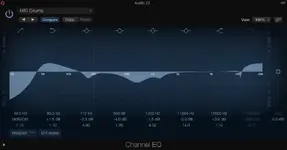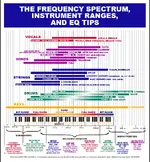P
PhilLondon
New member
Hey all!
I'm just starting to learn more about EQing and I have some questions.
Here is a template EQ that I pulled up in Logic just to use as an example to see if my understanding was correct. I understand what EQing is, and why we do it, but just reading the graph and knowing how and what to cut/boost is all new to me. If you have a few minutes please have a read and answer in really simple terms if you could.

- Everything from 20Hz is rolled off by approx -20 dB which by approx 45Hz is back to 0, and then boosted by around 4dB at 40Hz and then rolled back to 0 at around 140Hz. Does this mean that you can't hear anything at that range because it's been silenced, but as it reaches 35dB you can hear those frequencies clearer and by the time it reaches 45Hz that frequency should be audible, which are then boosted so that they are more pronounced at 50Hz?
- When people talk about a high pass filter, is it because it cuts the surrounding frequencies out so that you can boost other close frequencies, or keep them around 0dB so that they can be heard easier?
- Why don't you just cut all the way to 30dB? What's the point in only cutting by 10dB?
- Are the icons at the top just icons to indicate what range of the spectrum will be controlled if you select them?
- When looking at EQing, is this type of EQ the right one to use?
That's it for now! Thanks a lot.
I'm just starting to learn more about EQing and I have some questions.
Here is a template EQ that I pulled up in Logic just to use as an example to see if my understanding was correct. I understand what EQing is, and why we do it, but just reading the graph and knowing how and what to cut/boost is all new to me. If you have a few minutes please have a read and answer in really simple terms if you could.


- Everything from 20Hz is rolled off by approx -20 dB which by approx 45Hz is back to 0, and then boosted by around 4dB at 40Hz and then rolled back to 0 at around 140Hz. Does this mean that you can't hear anything at that range because it's been silenced, but as it reaches 35dB you can hear those frequencies clearer and by the time it reaches 45Hz that frequency should be audible, which are then boosted so that they are more pronounced at 50Hz?
- When people talk about a high pass filter, is it because it cuts the surrounding frequencies out so that you can boost other close frequencies, or keep them around 0dB so that they can be heard easier?
- Why don't you just cut all the way to 30dB? What's the point in only cutting by 10dB?
- Are the icons at the top just icons to indicate what range of the spectrum will be controlled if you select them?
- When looking at EQing, is this type of EQ the right one to use?
That's it for now! Thanks a lot.


